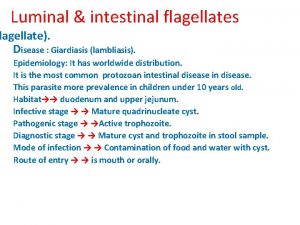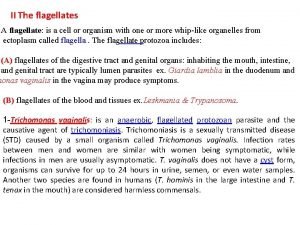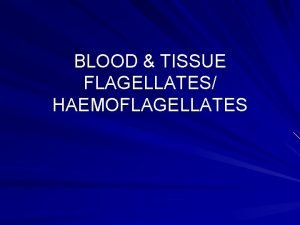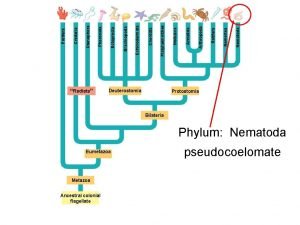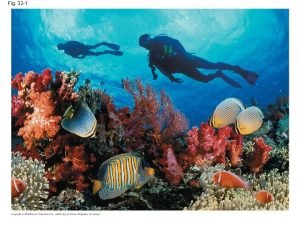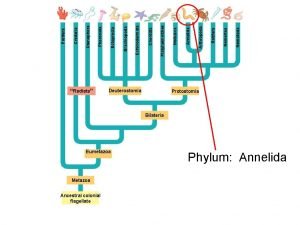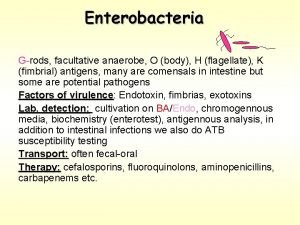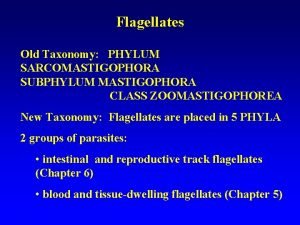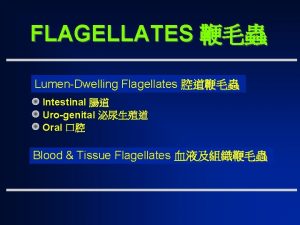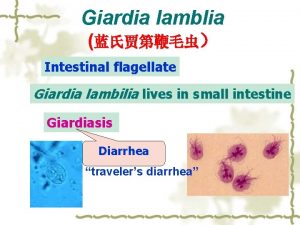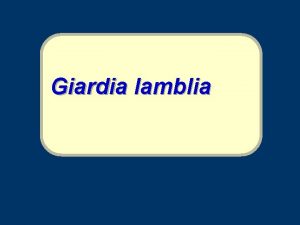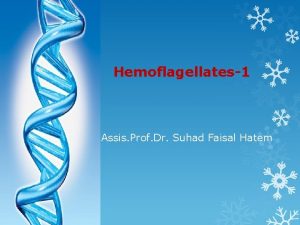II The flagellates A flagellate is a cell














- Slides: 14

II The flagellates A flagellate: is a cell or organism with one or more whip-like organelles from ectoplasm called flagella. The flagellate protozoa includes: (A) flagellates of the digestive tract and genital organs: inhabiting the mouth, intestine, and genital tract are typically lumen parasites ex. Giardia lamblia in the duodenum and monas vaginalis in the vagina may produce symptoms. (B) flagellates of the blood and tissues ex. Leshmania & Trypanosoma. 1 -Trichomonas vaginalis: is an anaerobic, flagellated protozoan parasite and the causative agent of trichomoniasis. Trichomoniasis is a sexually transmitted disease (STD) caused by a small organism called Trichomonas vaginalis. Infection rates between men and women are similar with women being symptomatic, while infections in men are usually asymptomatic. T. vaginalis does not have a cyst form, organisms can survive for up to 24 hours in urine, semen, or even water samples. Another two species are found in humans (T. hominis in the large intestine and T. tenax in the mouth) are considered harmless commensals.


TROPHOZOITE


Laboratory Diagnosis 1 - Classically, with a cervical smear, infected women have a transparent "halo" around their superficial cell nucleus. It is unreliably detected by studying a genital discharge or with a cervical smear because of their low sensitivity. T. vaginalis was traditionally diagnosed via a wet mount, in which "corkscrew" motility was observed. 2 -Currently, the most common method of diagnosis is via culture ex. Diamond' s 95%. 3 -Newer methods, such as rapid antigen testing and transcription-mediated amplification, PCR, using specific primers. .

2 -Trichomonas hominis This flagellate is cosmopolitan in its distribution. It is thought to be non-pathogenic although it has been associated with diarrhoeic stools. Laboratory Diagnosis: In a fresh stool, the flagellates move very rapidly in a jerky, non-directional manner. its swim with a characteristic wobbly movement, which makes them unmistakable during diagnosis.

3 - Giardia lamblia is a flagellated protozoan parasite that colonizes and reproduces in the small intestine, causing giardiasis. The parasite attaches to the epithelium by a ventral adhesive disc, and reproduces via binary fission. Giardiasis remains confined to the lumen of the small intestine. Giardia infection can occur through ingestion of dormant cysts in contaminated water, food, or by the fecal-oral route through poor hygiene practices CYST TROPHOZOITE

TROPHOZOITE

CYST

Laboratory Diagnosis 1 -Trophozoites are found by examination of saline wet preparations of fresh, diarrhoeic stool, duodenal or jejunal aspirate or in a permanently stained faecal preparation. 2 -Cysts can be found by examination of the deposit of a formol-ether concentrate of a stool preparation. The oval cysts with thick walls serve as characteristic features for these organisms. The flagella disintegrate and form a central ‘streak’ which becomes visible when stained with iodine or MIF (merthiolate-iodine-formaldehyde).

The Ciliates Balantidium coli is widely distributed in warmer climates, which is where human infections most commonly occur. The organisms inhabit the large intestine, cecum and terminal ileum where they feed on bacteria.

Morphology of the Cyst The cyst is spherical or ellipsoid and measures from 30 -200μm by 20 -120μm. It contains 1 macro and 1 micronucleus. The cilia are present in young cysts and may be seen slowly rotating, but after prolonged encystment, the cilia disappear. Cysts form when diarrhea subsides and the rectal contents become formed. The cyst, ingested by a fresh host, excysts to liberate the trophozoite.


Diagnosis: - Detection of trophozoit and cystic form of parasites in stool.
